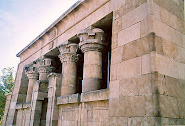
From the Evening Times online
I’ve cracked mystery of the Holy Grail
by Wendy Miller
Publication date 26/12/07
A GLASGOW historian believes he may have solved the world's most ancient mystery - and found the Holy Grail.
Mark Oxbrow is preparing to export his amazing discovery to the US leaving fans of book and movie blockbuster the Da Vinci Code with a new theory to consider.
During a trip to Paris, Mark, 36, from the West End, stumbled across what he believes is the real Holy Grail - and it's not a bloodline between Jesus and Mary Magdalene as claimed in the book and film.
While exploring medieval treasures in the Louvre, Mark found a green gem-encrusted serving dish which he thinks could have been used at the Last Supper.
Amazingly the French national treasure dates back to the time of Christ, matching descriptions of the Grail.
Mark's discovery is documented in a new book which has already sold thousands of copies - and is due to hit US and French bookstores in the New Year.
Mark's curiosity was aroused when he and wife Jill spotted the Patene de Serpentine tucked away in the medieval section of the Louvre Museum.
Back home Mark, a former Glasgow University lecturer, started to research the dish's origins, a trail that lead him closer and closer to the Holy Grail, the mystery which has confounded historians for centuries.
For hundreds of years now scholars and theologians have been unable to agree, even on the meaning of the Grail.
It used to be thought of as either the cup used to catch Christ's blood during his crucifixion or a dish used at the Last Supper.
Another theory is that the Grail is merely a Christian symbol while the Da Vinci Code controversially depicts it as the bloodline between Jesus and Mary Magdalene.
French poet Chretien de Troyes wrote numerous stories about the Grail which Mark's research links to the Patene, used to serve mass wafers in the sacred ceremonies of the French royal court from the 12th century onwards.
Mark, a historian and folklorist, said: "It's impossible to prove 100% that the Patene de Serpentine is the real Holy Grail.
"But the Patene is a sacred medieval treasure that perfectly matches every detail of the earliest descriptions of the Grail.
"It was in the right place at the right time.
"There is certainly a lot of interest in the theory."
Dating back to 100BC and 100AD, the dish is also engraved with tiny golden fish, an early symbol of Christianity.
An A to Z of King Arthur and the Holy Grail by Simon Cox and Mark Oxbrow is out now on Mainstream Publishing priced £12.99.
************************************************************************************
"Christian" fish symbols engraved on a dish used at the pre-Christian Jewish ceremony of Passover? Yeah, right.
Anything attributed to Jesus (and/or martyrs) coming out of the so-called Christian medieval period is automatically suspect in my book. I was, however, intrigued by the name of this dish because of the "serpetine," and did some further research on it.
After reading more about the piece, it appears that the name "serpentine" is the name of the green stone used in the center of the dish. It could also, on an outside shot, possibly apply to the pattern of the stone inset in the gold "trim" around the green stone base of the dish, which rather resembles the "scales" on a serpent. I'm still not quite clear on all of this, even after reading this entry at the Louvre Museum:
Original website (in French). Babelfish translation to English (as best I can figure out):
Patène serpentine
The patène consists of a saucer serpentine encrusted with gold fish, probably dating from the first century and a mount of gold adorned with stones, which are developing between the grounds of silverware compartmentalized, an association that we found until the beginning of the eleventh century.
She [it] accompanied at Saint-Denis' cut of the Ptolemies, "kantharos agate which was adapted mount goldsmith similar to patène (Paris, National Library, Cabinet Medal).
The treasure of Saint-Denis
The Patene serpentine from the treasure of Saint-Denis. In sandyonisienne history, it was always associated with the antique vase-cameo of Sardonyx (white and orange agate), sculptured reliefs bachiques nicknamed Cup Ptolemies. Both served at religious ceremonies queens of France at Saint-Denis, from the fifteenth century, the abbey acting as the coronation place of queens. Both remained famous works together in the treasury until 1791. At that time, the chalice was tabled to the Cabinet of Antiques. Stolen in 1804, but he [it] was found without his mount, which had been fondue: it is always kept at Cabinet today Medal of the National Library. However, the integration patène collections of the Museum since 1793.
The serpentine patène
It consists of two distinct and different epochs. The quality of the size of the apparent patène best works of the ancient glyptique before the first century and the first century AD, marbled dark green of the serpentine is inlaid with eight small gold fish (including Both [two?] are missing), probably added at the time of the Roman Empire for the liturgical use of the object.
The patronage of Charles the Bald in Saint-Denis
At the Carolingian period, the kantharos of sardonyx was transformed into a chalice from adding a foot decorated with a circular node decorated with precious stones. The elegant dish stone lasts lived also set with a set of silverware compartmentalized where gemstones embedded around pearls, garnets, colored glasses. The border compartmentalized illustrates the art of goldsmiths of the court of Charles the Bald, whose art reflected other objects prestigious offered by the king in Saint-Denis as the cross and the altar of gold disappeared today.














































